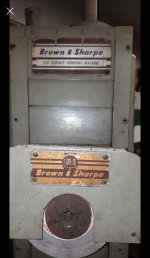Trex Fabrication
Plastic
- Joined
- Apr 25, 2021
Happy New Year All
I have the opportunity to acquire a Brown and Sharpe 510 Surface grinder.
it is a manual machine as many should know, but I have never owned a Surface Grinder before, so my question is is it a good ground level grinder or will I just want to upgrade soon after using? And is it a good value for the money? It is stated it works and all parts are moving and it has been in storage for 10 years, sitting in an old closed shop.
The offer was $770 then $500 now it is please make offer don't want to scrap...
I believe these machine are large and heavy with a limited market, so I may be able to make a really good deal..?? And save it from the scrap yard...
It is close to me and available, two key features in obtaining large vintage machinery as far as I am concerned.
Any input would be appreciated.




I have the opportunity to acquire a Brown and Sharpe 510 Surface grinder.
it is a manual machine as many should know, but I have never owned a Surface Grinder before, so my question is is it a good ground level grinder or will I just want to upgrade soon after using? And is it a good value for the money? It is stated it works and all parts are moving and it has been in storage for 10 years, sitting in an old closed shop.
The offer was $770 then $500 now it is please make offer don't want to scrap...
I believe these machine are large and heavy with a limited market, so I may be able to make a really good deal..?? And save it from the scrap yard...
It is close to me and available, two key features in obtaining large vintage machinery as far as I am concerned.
Any input would be appreciated.





